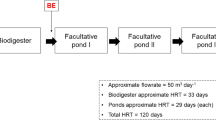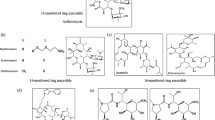Abstract
Treating sewage containing antibiotics is a complex process that needs research. An anaerobic method for organic matter removal from wastewater is the most optimal treatment option, which can provide antibiotic removal under the condition of prior adaptation of anaerobic microorganism association to antibiotic. The aims of the study were to obtain a microorganism association tolerant to antibiotics and to investigate the anaerobic association (methanogens) composition before and after adaptation. The subject of the study was the determination of microorganism association properties in conditions of high antibiotic concentration, which enables the determination of the adaptation mechanism. Adaptation of microorganism association to antibiotics was carried out by a gradual increase of antibiotic concentration in the nutrient medium (anaerobic conditions of detention, mesophilic regime). The qualitative and quantitative composition of biogas was determined by gas chromatography. DNA of microorganism associations was isolated by the agrobacteria DNA isolation method. The determination of archaeal 16SrRNA genes in DNA was performed by polymerase chain reaction (PCR). Information about gene structure was obtained by sequencing. It has been shown that the biogas output during anaerobic sewage treatment with antibiotic-adapted microorganism association increases regardless of antibiotic concentration. When enriching microorganism association with methanogens, tolerant to antibiotics, the biogas output grows by 32–38% depending on their amount. It was found that, when using tetracycline and norfloxacin, in the microorganism association methanogens of the genus Methanobacterium are dominant due to their resistance. Influence of antibiotics tetracycline and norfloxacin on raw materials leads to a decrease in the species volume of the Methanosarcinaceae family.







Similar content being viewed by others
Data Availability
Upon request by email corresponding author.
References
Ageyev, L. M., Korolkov, S. I. (1953). Chemical and technical control and accounting of hydrolysis and sulfite-alcohol production. Moscow: Goslesbumizdat (in Russ.).
Ahmed, M. B., Zhou, J. L., Ngo, H. H., & Guo, W. (2015). Adsorptive removal of antibiotics from water and wastewater: Progress and challenges. Science of the Total Environment, 532, 112–126.
Aydin, S., Ince, B., Cetecioglu, Z., Ozbayram, E. G., Shahi, A., Okay, O., & Ince, O. (2014). Performance of anaerobic sequencing batch reactor in the treatment of pharmaceutical wastewater containing erythromycin and sulfamethoxazole mixture. Water Science and Technology, 70(10), 1625–1632.
Battumur, U., Yoon, Y. M., & Kim, C. H. (2016). Isolation and characterization of a new Methanobacterium formicicum KOR-1 from an anaerobic digester using pig slurry. Asian-Australasian Journal of Animal Sciences, 29(4), 586–593.
Birosova, L., Mackulak, T., Bodík, I., Ryba, J., Skubak, J., & Grabic, R. (2014). Pilot study of seasonal occurrence and distribution of antibiotics and drug resistant bacteriain wastewater treatment plants in Slovakia. Sci. Total Environ., 490, 440–444.
Brody, J. R., & Kern, S. E. (2004). History and principles of conductive media for standard DNA electrophoresis. Analytical Biochemistry, 333, 1–13.
Cetecioglu, Z., Ince, B., Azman, S., Gokcek, N., & Coskun, O. (2013a). Determination of anaerobic and anoxic biodegradation capacity of sulfamethoxasole and the effects on mixed microbial culture. Ince. – InTech, 224–249.
Cetecioglu, Z., Ince, B., Gros, M., Rodriguez-Mozaz, S., Barceló, D., Orhon, D., & Ince, O. (2013b). Chronic impact of tetracycline on the biodegradation of an organic substrate mixture under anaerobic conditions. Water Research, 47, 2959–2969.
Chellapandi, P., Bharathi, M., Sangavai, C., & Prathiviraj, R. (2018). Methanobacterium formicicum as a target rumen methanogen for the development of new methane mitigation interventions: a review. Veterinary and Animal Science, 6, 86–94.
Chelliapan, S., & Sallis, P. J. (2013). Anaerobic biotechnology for pharmaceutical wastewater treatment. Research Journal of Pharmaceutical Biological and Chemical Sciences, 4, 1255–1261.
Chow, P. (2005). Cloning of λ DNA fragments into pUC19 vector to study the ligation efficiency of NdeI-digested pUC19 and HindIII-digested pUC19 by T4 DNA ligase. Journal of Experimental Microbiology and Immunology, 8–18.
Dhaese, P., De Greve, H., Decraemer, H., Schell, J., & Montagu, V. M. (1979). Rapid mapping of transposon insertion and deletion mutations in the large Ti-plasmids of Agrobacterium tumefaciens. Nucl. Acids Res., 7, 1837–1849.
Dridi, B., Fardeau, M. L., Ollivier, B., Raoult, D., & Drancourt, M. (2011). The antimicrobial resistance pattern of cultured human methanogens reflects the unique phylogenetic position of archaea. Journal of Antimicrobial Chemotherapy, 66(9), 2038–2044.
Gartiser, S., Urich, E., Alexy, R., & Kümmerer, K. (2007). Anaerobic inhibition and biodegradation of antibiotics in ISO test schemes. Chemosphere, 66, 1839–1848.
Golub, N. B., & Potapova, M. V. (2018). Technological solution of biogas output increasing at grain distillery spent wash fermentation. Innov Biosyst Bioeng, 2(3), 175–182.
Golub, N. B., Shynkarchuk, M. V., Shynkarchuk, A. V., Xinhua, S., Ying, Z., & Kozlovets, O. A. (2019). Vulnerabilities in the production of biogas from the fat-containing tannery waste. Innov Biosyst Bioeng, 3(4), 253–260.
Gorobets, S. V., Hetmanenko, K. A., Ponomarenko, D. S., Kovalyov, O. V., & Borovyk, I. V. (2018). Activated sludge biomass as magnetic biosorbent. Innov Biosyst Bioeng, 2(4), 262–270.
Ho, D. P., Jensen, P. D., & Batstone, D. J. (2013). Methanosarcinaceae and acetate-oxidizing pathways dominate in high-rate thermophilic anaerobic digestion of waste-activated sludge. Applied and Environmental Microbiology, 79(20), 6491–6500.
Kelly, W. J., Leahy, S. C., Li, D., Perry, R., Lambie, S. C., Attwood, G. T., & Altermann, E. (2014). The complete genome sequence of the rumen methanogen Methanobacterium formicicum BRM9. Standards in Genomic Sciences, 9, 15.
Kern, T., Fischer, M. A., Deppenmeier, U., Schmitz, R. A., & Rother, М. (2016). Methanosarcina flavescens sp. nov., a methanogenic archaeon isolated from a full-scale anaerobic digester. International Journal of Systematic and Evolutionary Microbiology, 66, 1533–1538.
Leibniz E, Struppe, H. G. (1988). Guide to gas chromatography. World Publishing House. (in Russ.).
Liu, H., Zhou, X., Huang, H., & Zhang, J. (2019). Prevalence of antibiotic resistance genes and their association with antibiotics in a wastewater treatment plant: process distribution and analysis. Water, 11(12), 2495.
Lodish, H., Berk, A., Zipursky, S. L., Matsudaira, P., Baltimore, D., & Darnell, J. (2000). Molecular cell biology (4th ed.). New York: W. H. Freeman.
Lu, M., Niu, X., Liu, W., Zhang, J., Wang, J., Yang, J., Wang, W., & Yang, Z. (2016). Biogas generation in anaerobic wastewater treatment under tetracycline antibiotic pressure. Nature. Scientific Reports, 6, 28336.
Lupan, I., Carpa, R., Oltean, A., Kelemen, B. S., & Popescu, O. (2017). Release of antibiotic resistant bacteria by a waste treatment plant from Romania. Microbes and Environments, 32(3), 219–225.
Lurye Yu. (1984). Analytical chemistry of industrial wastewater. Moscow: Khimiia. (in Russ.).
Marathe, N. P., Regina, V. R., Walujkar, S. A., Charan, S. S., Moore, E. R., Larsson, D. G., & Shouche, Y. S. (2013). A treatment plant receiving waste water from multiple bulk drug manufacturers is a reservoir for highly multi-drug resistant integron-bearing bacteria. PLoS One, 8(10), e77310.
Online document DNA purifications from various sources [homepage on the Internet]. Janos Luka’s Publications [cited 2019 Feb 21]. http://herpesvirus.tripod.com/research/protoDNA.htm.
Online document FIREPol® DNA Polymerase [homepage on the Internet]. Solis BioDyne [cited 2019 Feb 21]. https://www.solisbiodyne.com/pics/6221_Data_Sheet_FIREPol_DNA_Polymerase.pdf.
Pharmaceuticals in the environment: results of an EEA Workshop (EEA Technical Report) (2010). European Environment Agency 2010. https://doi.org/10.2800/31181.
Shi, H., Ni, J., Zheng, T., Wang, X., Wu, C., & Wang, Q. (2020). Remediation of wastewater contaminated by antibiotics. A review. Environmental Chemistry Letters, 18, 345–360.
Sleytr, U. В., Schuster, В., Egelseer, E. M., & Pum, D. (2014). S-layers: Principles and applications. FEMS Microbiology Reviews, 38, 823–864.
Van den Bergh, B., Fauvart, M., & Michiels, J. (2017). Formation, physiology, ecology, evolution and clinical importance of bacterial persisters. FEMS Microbiology Reviews, 41(3), 219–251.
Whitehead, T. R., & Cotta, M. A. (1999). Phylogenetic diversity of methanogenic archaea in swine waste storage pits. FEMS Microbiology Letters, 179, 223–226.
Zhang, W., Huang, M., Qi, F., Sun, P., & Van Ginkel, S. W. (2013). Effect of trace tetracycline concentrations on the structure of a microbial community and the development of tetracycline resistance genes in sequencing batch reactors. Bioresource Technology, 150, 9–14.
Zhu, J., Zheng, H., Ai, G., Zhang, G., Liu, D., Liu, X., & Dong, X. (2012). The genome characteristics and predicted function of methyl-group oxidation pathway in the obligate aceticlastic methanogens, Methanosaeta spp. PLoS One, 7(5), e36756.
Acknowledgments
The authors thank Igor Levtun for the technical assistance provided in writing up this manuscript. Also, authors thank colleagues from Institute of Cell Biology and Genetic Engineering who provided insight and expertise that greatly assisted the research.
Author information
Authors and Affiliations
Contributions
Experiment planning: N. B. Golub
Conducting anaerobic digestion, preparation of test samples: N. B. Golub, M. V. Shinkarchuk, O. A. Kozlovet
DNA isolation, molecular analyzes: O. R. Lakhneko, B. V. Morgun, M. V. Shinkarchuk
Sequencing: A. I. Stepanenko, M. V. Borisjuk
Corresponding author
Ethics declarations
Conflict of Interest
The authors declare that they have no conflict of interest.
Additional information
Publisher’s Note
Springer Nature remains neutral with regard to jurisdictional claims in published maps and institutional affiliations.
Rights and permissions
About this article
Cite this article
Golub, N.B., Shinkarchuk, M.V., Kozlovets, O.A. et al. Determination of Biogas Producers in Antibiotic-Containing Sewage. Water Air Soil Pollut 231, 445 (2020). https://doi.org/10.1007/s11270-020-04805-6
Received:
Accepted:
Published:
DOI: https://doi.org/10.1007/s11270-020-04805-6




